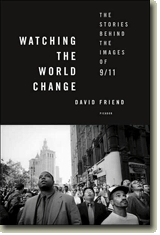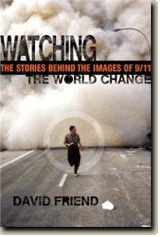November 2007 Archives
« Previous · Home · Next »
November 22, 2007
THE PLIGHT OF AN AP PHOTOGRAPHER
For more than a year and a half now, an Iraq-based Associated Press photographer, Bilal Hussein, has been held by the U.S. military on vague charges of abetting the anti-American insurgency. Only this week have authorities released details about the case of Hussein (part of the 2005 AP team that won a Pulitzer Prize for photography), insisting that during a search of his apartment in Iraq last year, troops discovered, according to yesterday's New York Times, "explosive devices, insurgency propaganda and surveillance photographs of an installation for American-led forces." What's more, according to officials, Hussein "had made offers to provide false identity papers to an Iraqi sniper seeking to elude American custody [and] had taken photographs so synchronous with bomb attacks that it seemed that he had prior knowledge of the attacks."

As I cautionary tale, however, I urge readers to recall the case of "Yunis," an Iraqi journalist and cameraman working for various Western news agencies, who was detained and held by U.S. forces in 2005 on what proved to be absurd, trumped-up charges of plotting to assassinate British prime minister Tony Blair. Yunis, whose ordeal was chronicled in Michael Tucker's disturbing 2007 documentary, The Prisoner, happened to be in the wrong place at the wrong time when he was taken by U.S. troops in a midnight dragnet. He sustained months of psychological and physical abuse at the hands of his American captors at Abu Ghraib, only to emerge as a key liaison there between the U.S. authorities and the prisoners, the vast majority of whom, like Yunis, turned out to be innocent civilians.
Tucker also wrote a moving account, for VanityFair.com, which I edited, describing the relationship between Yunis and Benjamin, one of the Abu Ghraib guards who became his friend at the camp. It is an inspiring tale that, especially at this time of year, has real resonance and a surprising degree of hope about the human condition.

With regard to the case of the AP's Bilal Hussein, please read news accounts of the American military's charges HERE -- and the response by the Associated Press HERE. Clearly, I have no idea whether Hussein is innocent or guilty, but before passing judgment, please remember the ill-fated Yunis, who, until recently, was still courageously plying his trade in Iraq.
"THE DEVIOUS LIE OF THE SNAPSHOT"
In the new issue of The Chronicle of Higher Education, Professor Louis Masur, the renowned scholar who heads up the American Studies program at Trinity (Connecticut) College, has a fascinating piece, “How the Truth Gets Framed By the Camera,” in which he calls Watching the World Change “insightful and moving.” (Masur teaches the book in two of his classes.)
In the context of the term “the devious lie of the snapshot”--a phrase coined by Magnum photographer Thomas Hoepker--Masur presents a lengthy discussion of Hoepker’s September 11 photograph, below, which was first published in the U.S. in 2006 (in Watching the World Change) and emerged on the cultural radar thanks to a pivotal column by Frank Rich, of The New York Times, on the eve of the fifth anniversary of the 9/11 attacks. Interpretations of the photograph and heated exchanges were then posted on blogs and on news and media-related Websites.

I encourage readers to absorb Masur's essay. To revisit the back-and-forth about Frank Rich's original column on Slate, Gawker, The Washington Post, The New York Times online, etc., CLICK HERE and HERE and HERE.
November 14, 2007
THE NAUDETS' NEW SPIRITUAL QUEST
Gedeon and Jules Naudet were the French filmmakers behind the 2002 CBS special 9/11, which aired in 140 nations, raised more than $2 million for the Uniformed Firefighters Association Scholarship Fund and earned both a Peabody and an Emmy Award (for best documentary). I served as an executive producer of the program and wrote about the Naudet brothers' 9/11 ordeal in Watching the World Change (pages 182-195), extensively and exclusively, thanks to our having been family friends for many, many years.
Today, CBS announced that it is broadcasting the Naudets' next effort in prime time next month. Their documentary, called In God's Name, was two years in the making. It focuses on the daily lives and inner beliefs of the 12 leaders of the 12 major world religions. The brothers, judging from the rough cuts and trailer I've seen, have produced a truly unique and unprecedented film -- visiting these spiritual figures in their prayer settings, in their bedrooms, and going about their daily rituals. Each religious figure was asked to address fundamental questions about his or her faith. The documentary contains breathtaking footage from around the globe and will take viewers on a spiritual pilgrimage that has the intimacy of a religious retreat and yet the sweep of a David Leen or Richard Attenborough epic.
The Naudets' Special will air December 23 on CBS. Check your local listings for the time in your area.
TRINITY TRIP
I had a blast on my visit to Trinity College in Hartford, Connecticut, to deliver the annual Jan Cohn Visiting Scholar Lecture in American Studies (what a mouthful!)
Though I'm traveling, I wanted to provide a link to a piece about the event that was posted today on the Website for the school's weekly newspaper, The Trinity Tripod.
My thanks to Professor Louis Masur, who encourages students to recognize photography's pivotal role in how we view history, to Trinity's thoroughly engaging students, to the bartenders at The Tap (who were generous with Bass Ale pitchers) and to Aileen McBride who wrote the article to which I've linked, above.
Speaking of pictures: Thanks also to Dorothy Thompson for taking a photograph for the paper that doesn't make me cower. Quite a feat.

PHOTO BY DOROTHY THOMPSON/TRINITY TRIPOD
November 10, 2007
THE ELECTRONIC ROAD TO MANDALAY
The Bush administration had encouraged the return from exile of Pakistan’s former prime minister Benazir Bhutto as a way of discouraging foment, encouraging democracy, and bolstering the power base of one of America’s chief allies in the war on terror: current prime minister Pervez Musharraf. Bhutto arrived amid much fanfare and, for a time at least, brought with her a glint of promise and of compromise, despite her own checkered political history. But as Helene Cooper writes in today’s New York Times, “The images coming out of Pakistan -- of police forces blanketing the site of a planned rally by Ms. Bhutto, the opposition leader, and then barricading her insider her residence – were hardly consistent with the kind of cooperation the United States promoted.”
The photographs – showing Bhutto with supporters, as if cocooned by coils razor wire – hint at the roiling situation outside the lens. (She was allowed to leave her home later in the day.) The world continues to monitor the showdown with trepidation, not only because of the internal bloodletting the pictures portend, but because of Pakistan’s pivotal role in the Taliban/al-Qaeda equation, its place as a staging ground for U.S. forays into Afghanistan, its reputation as a haven for insurgents, and its possession of nuclear weapons. Not to mention the long-simmering tensions that always seem to flare up with neighboring India.
The smart money has it that the situation will all get much worse across Pakistan before it gets better. And the pictures support this contention. Earlier this week, the world’s front pages showed Pakistani lawyers in suits and ties – enraged at the suspension of the Constitution, the jailing of jurists, the firing of the Chief Justice of the Supreme Court, the dubious election results, Musharraf’s refusal to rescind his military title, and the imposition of emergency rule -- gathered en masse to confront the military and to hurl back at the troops their own tear gas cannisters.
Such images reminded me of recent news photos coming out of Burma (Myanmar): lines of monks snaking through supportive crowds, their robes the hue of a fiery sunrise; a lone photographer lifeless in the street, slain like a dog by a government gun.
THIS CLIP IS VIEWABLE HERE
Indeed, as has recently been pointed out by my friend Seth Mydans, a correspondent for the International Herald Tribune and The New York Times, it is precisely because footage like this made it into the slipstream of the international press, courtesy of TV, newspapers, and the Web, that the monks’ opposition became magnified, became a threat, became sustained over days and weeks. As Mydans wrote so cogently in the Times on October 4:
“It was about as simple and uncomplicated as shooting demonstrators in the streets. Embarrassed by smuggled video and photographs that showed their people rising up against them, the generals who run Myanmar simply switched off the Internet. Until Friday television screens and newspapers abroad were flooded with scenes of tens of thousands of red-robed monks in the streets and of chaos and violence as the junta stamped out the biggest popular uprising there in two decades. But then the images, text messages and postings stopped, shut down by generals who belatedly grasped the power of the Internet to jeopardize their crackdown.
“….Along with the Internet, the junta cut off most telephone access to the outside world. Soldiers on the streets confiscated cameras and video-recording cellphones.…
“‘There are always ways people find of getting information out, and authorities always have to struggle with them,’ said Mitchell Stephens, a professor of journalism at New York University and the author of A History of News. ‘There are fewer and fewer events that we don’t have film images of: the world is filled with Zapruders,’ he said, referring to Abraham Zapruder, the onlooker who recorded the assassination of President John F. Kennedy in 1963.’
“Before Friday’s blackout, Myanmar’s hit-and-run journalists were staging a virtuoso demonstration of the power of the Internet to outmaneuver a repressive government. A guerrilla army of citizen reporters was smuggling out pictures even as events were unfolding, and the world was watching….
“‘Today every citizen is a war correspondent,’ said Phillip Knightley, author of The First Casualty, a classic history of war reporting that starts with letters home from soldiers in Crimea in the 1950s and ends with the ‘living room war’ in Vietnam in the 1970s, the first war that people could watch on television. ‘Mobile phones with video of broadcast quality have made it possible for anyone to report a war.’”
In light of these insights, consider these passages from Watching the World Change (page 388):
“When the 2005 bombings devastated the London transit system, and passengers immediately snapped pictures, they had crossed the Rubicon. The ever open-ended War on Terror – whose domain has been expanded by terrorists and politicians alike to encompass the entire planet – had conscripted unsuspecting citizens, as they went about their business, as nothing less than battlefield photographers, armed with cell phones, digital cameras, and camcorders.”
In fact, the transformative power of the Burmese monks’ opposition, and of the photos and press accounts that made it out to the West last month, was much in evidence this week. Burma’s dictators, prodded by the international community and by U.N. envoy Ibrahim Gambari, finally agreed to allow the country’s chief critic, Nobel laureate Daw Aung San Suu Kyi, to meet with fellow opposition leaders, an encounter that hasn’t been allowed there in three years.
For more of Seth Mydans’ pearls of wisdom, go to pages 278-279 of Watching the World Change.
MISCELLANY….
TRINITY TRIP. I hope to write soon about a terrific visit last week in which I spoke about the book at Trinity College in Hartford, Connecticut.
--SMITH GRANT RECIPIENT. This year, the W. Eugene Smith Fund awarded its annual $30,000 photojournalism grant to Australia’s Stephen Dupont for his project “Narcostan” (about the impact of the heroin trade on war-weary Afghanistan). I served as head of the Smith jury -- along with Beijing-based photojournalist and editor Wang Yao (vice president of China News Service) and photographer Sylvia Plachy, renowned for her work in The New Yorker and The Village Voice. The fund also granted stipends to Irish-born, London-based photographer Seamus Murphy and to Italy’s Stefano deLuigi.

--GET YOUR HANDS ON A HERO. Out this month is Schapiro's Heroes, a book from photographer Steve Schapiro, best known for his civil rights imagery and his celebrity coverage for Life, Look, The New York Times Magazine and various film studios. I wrote the introduction to the book, which is viewable as this month's cover story on The Digital Journalist Web site.
I urge all visitors to buy or order a copy this holiday season.

--SMACK YOU BACK. And striking a different note entirely: I’m serving as an adviser to a new Web-based humor service, ComedySmack, hatched two weeks ago by my friend David Moore, a high-powered entrepreneur and a staple on the New York stand-up circuit, who often headlines at Caroline’s Comedy Club. Check it out and please sign up. It's free.


